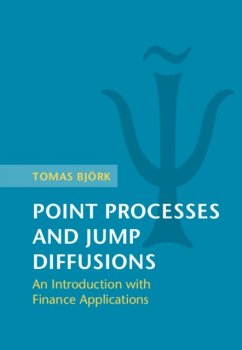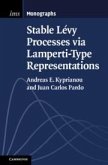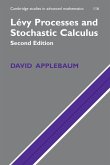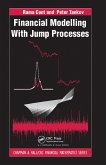Tomas Bjoerk (Stockholm School of Economics)
Point Processes and Jump Diffusions
An Introduction with Finance Applications
Tomas Bjoerk (Stockholm School of Economics)
Point Processes and Jump Diffusions
An Introduction with Finance Applications
- Gebundenes Buch
- Merkliste
- Auf die Merkliste
- Bewerten Bewerten
- Teilen
- Produkt teilen
- Produkterinnerung
- Produkterinnerung
Combining intuitive understanding with rigorous mathematical theory, this book introduces the theory of marked point processes on the real line, including filtering and application to financial economics. Graduate-level mathematicians and economists will gain a working knowledge of the field and a deep understanding of the key concepts and proofs.
Andere Kunden interessierten sich auch für
![Stochastic Finance Stochastic Finance]() Amanda Turner (University of Leeds)Stochastic Finance49,99 €
Amanda Turner (University of Leeds)Stochastic Finance49,99 €![Graph Spectra for Complex Networks Graph Spectra for Complex Networks]() Piet Van Mieghem (The Netherlands Technische Universiteit Delft)Graph Spectra for Complex Networks59,99 €
Piet Van Mieghem (The Netherlands Technische Universiteit Delft)Graph Spectra for Complex Networks59,99 €![Stable Lévy Processes Via Lamperti-Type Representations Stable Lévy Processes Via Lamperti-Type Representations]() Andreas E. Kyprianou (University of Bath)Stable Lévy Processes Via Lamperti-Type Representations68,99 €
Andreas E. Kyprianou (University of Bath)Stable Lévy Processes Via Lamperti-Type Representations68,99 €![Levy Processes and Stochastic Calculus Levy Processes and Stochastic Calculus]() David Applebaum (University of Sheffield)Levy Processes and Stochastic Calculus100,99 €
David Applebaum (University of Sheffield)Levy Processes and Stochastic Calculus100,99 €![Financial Modelling with Jump Processes Financial Modelling with Jump Processes]() Rama Cont (Mathematical Institute, University of Oxford, UK)Financial Modelling with Jump Processes134,99 €
Rama Cont (Mathematical Institute, University of Oxford, UK)Financial Modelling with Jump Processes134,99 €![Basic Stochastic Processes Basic Stochastic Processes]() Pierre Devolder (Universite Catholique de Louvain)Basic Stochastic Processes159,99 €
Pierre Devolder (Universite Catholique de Louvain)Basic Stochastic Processes159,99 €![Air Entrainment in Free-surface Flow Air Entrainment in Free-surface Flow]() I.R. Wood (ed.)Air Entrainment in Free-surface Flow267,99 €
I.R. Wood (ed.)Air Entrainment in Free-surface Flow267,99 €-
-
-
Combining intuitive understanding with rigorous mathematical theory, this book introduces the theory of marked point processes on the real line, including filtering and application to financial economics. Graduate-level mathematicians and economists will gain a working knowledge of the field and a deep understanding of the key concepts and proofs.
Produktdetails
- Produktdetails
- Verlag: Cambridge University Press
- Seitenzahl: 320
- Erscheinungstermin: 19. August 2021
- Englisch
- Abmessung: 248mm x 170mm x 23mm
- Gewicht: 694g
- ISBN-13: 9781316518670
- ISBN-10: 1316518671
- Artikelnr.: 62047451
- Herstellerkennzeichnung
- Libri GmbH
- Europaallee 1
- 36244 Bad Hersfeld
- gpsr@libri.de
- Verlag: Cambridge University Press
- Seitenzahl: 320
- Erscheinungstermin: 19. August 2021
- Englisch
- Abmessung: 248mm x 170mm x 23mm
- Gewicht: 694g
- ISBN-13: 9781316518670
- ISBN-10: 1316518671
- Artikelnr.: 62047451
- Herstellerkennzeichnung
- Libri GmbH
- Europaallee 1
- 36244 Bad Hersfeld
- gpsr@libri.de
Tomas Björk is Professor Emeritus of Mathematical Finance at the Stockholm School of Economics and previously worked at the Mathematics Department of the Royal Institute of Technology, Stockholm. Björk has been co-editor of Mathematical Finance, on the editorial board for Finance and Stochastics and several other journals, and was President of the Bachelier Finance Society. He is particularly known for his research on point-process-driven forward-rate models, finite-dimensional realizations of infinite dimensional SDEs, and time-inconsistent control theory. He is the author of the well-known textbook Arbitrage Theory in Continuous Time (1998), now in its fourth edition.
Part I. Point Processes: 1. Counting processes
2. Stochastic integrals and differentials
3. More on Poisson processes
4. Counting processes with stochastic intensities
5. Martingale representations and Girsanov transformations
6. Connections between stochastic differential equations and partial integro-differential equations
7. Marked point processes
8. The Itô formula
9. Martingale representation, Girsanov and Kolmogorov
Part II. Optimal Control in Discrete Time: 10. Dynamic programming for Markov processes
Part III. Optimal Control in Continuous Time: 11. Continuous-time dynamic programming
Part IV. Non-Linear Filtering Theory: 12. Non-linear filtering with Wiener noise
13. The conditional density
14. Non-linear filtering with counting-process observations
15. Filtering with k-variate counting-process observations
Part VI. Applications in Financial Economics: 16. Basic arbitrage theory
17. Poisson-driven stock prices
18. The simplest jump-diffusion model
19. A general jump-diffusion model
20. The Merton model
21. Determining a unique Q
22. Good-deal bounds
23. Diversifiable risk
24. Credit risk and Cox processes
25. Interest-rate theory
26. Equilibrium theory
References
Index of symbols
Subject index.
2. Stochastic integrals and differentials
3. More on Poisson processes
4. Counting processes with stochastic intensities
5. Martingale representations and Girsanov transformations
6. Connections between stochastic differential equations and partial integro-differential equations
7. Marked point processes
8. The Itô formula
9. Martingale representation, Girsanov and Kolmogorov
Part II. Optimal Control in Discrete Time: 10. Dynamic programming for Markov processes
Part III. Optimal Control in Continuous Time: 11. Continuous-time dynamic programming
Part IV. Non-Linear Filtering Theory: 12. Non-linear filtering with Wiener noise
13. The conditional density
14. Non-linear filtering with counting-process observations
15. Filtering with k-variate counting-process observations
Part VI. Applications in Financial Economics: 16. Basic arbitrage theory
17. Poisson-driven stock prices
18. The simplest jump-diffusion model
19. A general jump-diffusion model
20. The Merton model
21. Determining a unique Q
22. Good-deal bounds
23. Diversifiable risk
24. Credit risk and Cox processes
25. Interest-rate theory
26. Equilibrium theory
References
Index of symbols
Subject index.
Part I. Point Processes: 1. Counting processes
2. Stochastic integrals and differentials
3. More on Poisson processes
4. Counting processes with stochastic intensities
5. Martingale representations and Girsanov transformations
6. Connections between stochastic differential equations and partial integro-differential equations
7. Marked point processes
8. The Itô formula
9. Martingale representation, Girsanov and Kolmogorov
Part II. Optimal Control in Discrete Time: 10. Dynamic programming for Markov processes
Part III. Optimal Control in Continuous Time: 11. Continuous-time dynamic programming
Part IV. Non-Linear Filtering Theory: 12. Non-linear filtering with Wiener noise
13. The conditional density
14. Non-linear filtering with counting-process observations
15. Filtering with k-variate counting-process observations
Part VI. Applications in Financial Economics: 16. Basic arbitrage theory
17. Poisson-driven stock prices
18. The simplest jump-diffusion model
19. A general jump-diffusion model
20. The Merton model
21. Determining a unique Q
22. Good-deal bounds
23. Diversifiable risk
24. Credit risk and Cox processes
25. Interest-rate theory
26. Equilibrium theory
References
Index of symbols
Subject index.
2. Stochastic integrals and differentials
3. More on Poisson processes
4. Counting processes with stochastic intensities
5. Martingale representations and Girsanov transformations
6. Connections between stochastic differential equations and partial integro-differential equations
7. Marked point processes
8. The Itô formula
9. Martingale representation, Girsanov and Kolmogorov
Part II. Optimal Control in Discrete Time: 10. Dynamic programming for Markov processes
Part III. Optimal Control in Continuous Time: 11. Continuous-time dynamic programming
Part IV. Non-Linear Filtering Theory: 12. Non-linear filtering with Wiener noise
13. The conditional density
14. Non-linear filtering with counting-process observations
15. Filtering with k-variate counting-process observations
Part VI. Applications in Financial Economics: 16. Basic arbitrage theory
17. Poisson-driven stock prices
18. The simplest jump-diffusion model
19. A general jump-diffusion model
20. The Merton model
21. Determining a unique Q
22. Good-deal bounds
23. Diversifiable risk
24. Credit risk and Cox processes
25. Interest-rate theory
26. Equilibrium theory
References
Index of symbols
Subject index.








